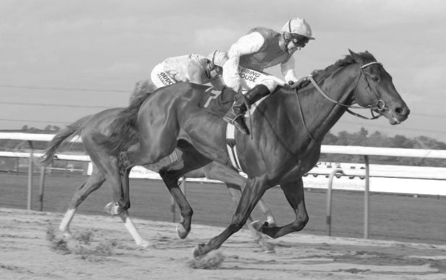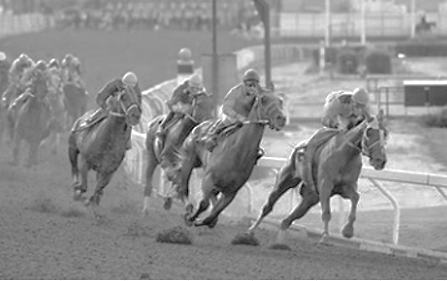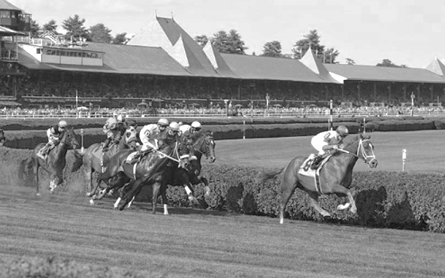
Top Ten Lists……….
America’s Best Horses of the 20th Century
This is the wild finish in the 1917 Brooklyn Handicap at Aqueduct Race Track. Harry Payne Whitney’s Borrow slipped through on the rail to defeat his stablemate, the outstanding mare Regret, by a nose. This race featured three Kentucky Derby winners and three Horse of the Year winners. (PHOTO: Cook Collection – Keeneland Library)
By: Walter Lazary /// January, 2024.
Picking what one considers to be the best in any field is always a challenging task. And when it comes to making a case for the best American thoroughbred racehorses that competed during the twentieth century, you can honestly say that making this determination is definitely not an exact science because personal judgment counts just as much, and sometimes even more, than actual facts. There are so many variables to consider, such as racing in different eras, major races won, overall record, weights carried, the quality of the competition, track conditions, injuries, career longevity, foal crop sizes, trainer and jockey expertise, breeding, etc.
There have been many versions of the top ten American Thoroughbred Race Horses of the Twentieth Century. Some make sense, while others leave even the most passionate racing fan puzzled. At HorseRacing20thCentury99.com, we have brought together lists compiled by three of the most respected American publications: BloodHorse Magazine, the Associated Press, and Sports Illustrated. Their top ten lists are similar in many ways, but there are some variations.
BloodHorse
The most famous ranking of the best American Thoroughbred Racehorses that competed during the past century is the one compiled by BloodHorse Magazine. This enormous task was conducted in 1999 and immediately grabbed the attention of racing fans interested in knowing which famous stars who competed between 1900 and 1999 were considered the best – and in order.
The BloodHorse panel consisted of seven distinguished members of the horseracing community: Howard Battle, the racing secretary at Keeneland race track; Lenny Hale, a vice-president of the Maryland Jockey Club; Pete Peterson, a senior steward in California; Daily Racing Form columnist Jay Hovdey; William Nack, a senior writer for Sports Illustrated; racing journalist Jennie Rees of the Louisville Courier-Journal; and Tommy Trotter, a steward at Gulfstream Park who was also a long time racing secretary on the NYRA circuit and for many years curator of the Experimental Free Handicap.
Each member was required to compile a list of what they considered the top one hundred American racehorses that ran in the past century, with their choices ranked from first to one hundredth. These lists were then combined into a master list, which was eventually published into a book: Thoroughbred Champions – Top 100 Racehorses of the 20th Century, complete with general biographies and career records.
In all, a total of 192 horses received at least one vote, and when the final tally was disclosed, it determined that Man o’ War was considered the best American racehorse to have competed during the twentieth century, winner by a narrow margin over Secretariat.
However, when examining the voting, one might say there was a noticeable flaw. In the final tally, Man o’ War and Secretariat received three first-place votes each, with Citation receiving the other. What decided the outcome was the fact that Secretariat was actually placed 14th on one of the ballots, a decision that caused the great Meadow Stable star the honor of being placed first, or at least being tied for first. Predictably, whether Secretariat’s 14th place ranking was an oversite or was made in jest, it raised questions about the method used and why at least one panel member (who some thought was biased) was included.
When William Nack reviewed the results he became outraged because, in his mind, there was no way that Secretariat should have been listed as the fourteenth best. And because of this one panel member’s decision, the result was skewered for many people and still begs the question – which of these two outstanding stars was the best American racehorse to compete in the Twentieth Century? Was it Samuel Riddle’s Man o’ War? Or was it the Meadow Stable’s Secretariat
Listed below, on the left is the BloodHorse Top Ten, and on the right, their #11 through #20:
1 – Man o’ War
2 – Secretariat
3 – Citation
4 – Kelso
5 – Count Fleet
6 – Dr. Fager
7 – Native Dancer
8 – Forego
9 – Seattle Slew
10 – Spectacular Bid
11 – Tom Fool
12 – Affirmed
13 – War Admiral
14 – Buckpasser
15 – Colin
16 – Damascus
17 – Round Table
18 – Cigar
19 – Bold Ruler
20 – Swaps
You might say that publishing this list was a thankless task because, in the end, it didn’t matter what order the panel produced, there were countless arguments put forth by those who thought otherwise. For instance, why would Dr. Fager make the top ten list while Damascus, who split four meetings with the great Tartan Farm star, not make the top ten despite his excellent record? And then there is Swaps, the 1955 Kentucky Derby winner who set four world records and three additional track records at various distances on dirt and showed his versatility when tying a world record on turf. The best this son of Khaled could do was finish twentieth, but one wonders where Swaps would have been placed if he had won his celebrated match race against Nashua, the 1955 Preakness Stakes and Belmont Stakes winner, who was #24 on the list.
Associated Press
Other lists were published, one of the most notable by The Associated Press. Its panel (I do not know the names of those who voted other than they were racing experts) chose the following:
1 – Man of War
2 – Secretariat
3 – Citation (tie)
3 – Native Dancer (tie)
5 – Kelso
6 – Tom Fool
7 – Dr. Fager
8 – Count Fleet
9 – Spectacular Bid
10 – Seattle Slew (tie)
10 – Forego (tie)
When the individual panel members were asked who they thought was best, four chose Man o’ War, one named Secretariat and the other named Tom Fool.
Sports Illustrated
Sports Illustrated Magazine created a list of the best racehorses in the past century. It was compiled by a panel of seven experts: ABC Sports broadcaster Jim McKay; Arlington International Racecourse steward Tommy Trotter (yes that same Tommy Trotter); retired California racing official Frank E. Kilroe; executive columnist of the Daily Racing Form Joe Hirsch; Hall of Fame trainer Woody Stephens; secretary-treasurer of the National Turf Writers Association, Jim Bolus; and columnist and author William F. Reed. Listed below are the horses that they believe were the top ten from the past century:
1 – Man o’ War
2 – Secretariat
3 – Citation
4 – Kelso
5 – Count Fleet
6 – Sysonby
7 – Native Dancer
8 – Nashua
9 – Seattle Slew
10 – Colin
A Century of Champions
Many of you may have heard of and possibly read the book “A Century of Champions” by John Randall and Tony Morris. Published in 1999, it rates all horses worldwide that competed between 1900 and 1999 regardless of age, sex, and distance requirements. These ratings are based on the Timeform scale, which was introduced in 1947, and are expressed in pounds. The highest rating given during the twentieth century is the 145 assigned French-bred Sea-Bird based on his 1966 twelve-furlong Arc de la Triomphe, which he won on soft turf by six lengths over Reliance, who has a Timeform rating of 137.
The second highest Timeform rating in the twentieth century was 144 assigned to Secretariat, representing his world record time of 2:24 flat for twelve furlongs on dirt. At that time, Beyer Speed Figures were unheard of and would not be officially developed until the late 1980s. However, Andrew Beyer said that Secretariat would have been given an astronomical 139 Beyer for his Belmont, which is six points higher than the highest official Beyer of 133 assigned to the sprinter Groovy in 1987. When converting Beyer Speed Figures to Timeform ratings, the accepted rule of thumb is to (a) add 12 to 14 points when converting Beyer numbers to Timeform numbers and (b) deduct 12 to 14 points when converting Timeform numbers to Beyer Speed Figures. Taking this into account, Secretariat should be given a Timeform rating of 151 to 153, and Sea-Bird would be given a Beyer Speed Rating of 131 to 133.
Following is how Timeform rated the top ten American horses in the twentieth century based on: (a) Country Rating, (b) Date of Birth, (c) Timeform Weight Assigned, and (d) Overall Timeform Placing for all horses regardless of where they raced in the twentieth century:
1 – Secretariat (1970) 144 (2nd)
2 – Citation (1945) 142 (5th)
3 – Spectacular Bid (1976) 141 (9th)
4 – Seattle Slew (1974) 141 (11th)
5 – Native Dancer (1950) 140 (13th)
6 – Affirmed (1975) 140 (14th)
7 – Man of War (1917) 139 (21st)
8 – Alydar (1975) 139 (23rd)
9 – Count Fleet (1940) 139 (26th)
10 – Swaps (1952) 138 (29th)
11 – Forego (1970) 138 (31st)
12 – Cigar (!990) 138 (32nd)
13 – Dr. Fager (1964) 138 (36th)
14 – Kelso (1957) 137 (44th)
15 – Nashua (1952) 137 (46th)
16 – Buckpasser (1963) 137 (47th)
17 – Tom Fool (1949) 137 (53st)
18 – Sunday Silence (1986) 137 (57th)
19 – Damascus (1964) 137 (60th)
20 – Easy Goer (1986) 137 (64th)
HorseRacing20thCentury99.com
Because I am posting a blog that will concentrate on North American Thoroughbred Horse Racing in the nineteenth and specifically the twentieth centuries, we at HorseRacing20thCentury99 have decided to post our own top ten list of those horses that competed during the 20th century (and no, neither Swaps nor Damascus made the top ten though both were close). Following our top ten, we have listed our next best ten.
We have also decided to go outside the box and publish several more concentrated lists: the Best Fillies and Mares, the Best Turf Horses, and the Best Turf Fillies and Mares.
We would also like to salute other horses whose extraordinary accomplishments might have been enough for them to be included in the BloodHorse top 100 but for some reason were omitted, such greats as Conquistador Cielo, Landaluce, Graustark, Hoist the Flag, Gen. Duke, Melair, and Swale, etc., forgotten stars that had their careers tragically cut short by injury, illness or stud syndication.
1 – (T) Man o’ War
1 – (T) Secretariat
3 – Citation
4 – Kelso
5 – Dr. Fager
6 – Affirmed
7 – Spectacular Bid
8 – Forego
9 – Native Dancer
10 – Seattle Slew
11 – Tom Fool
12 – Buckpasser
13 – Damascus
14 – Swaps
15 – Bold Ruler
16 – Count Fleet
17 – Round Table
18 – War Admiral
19 – Cigar
20 – Colin




